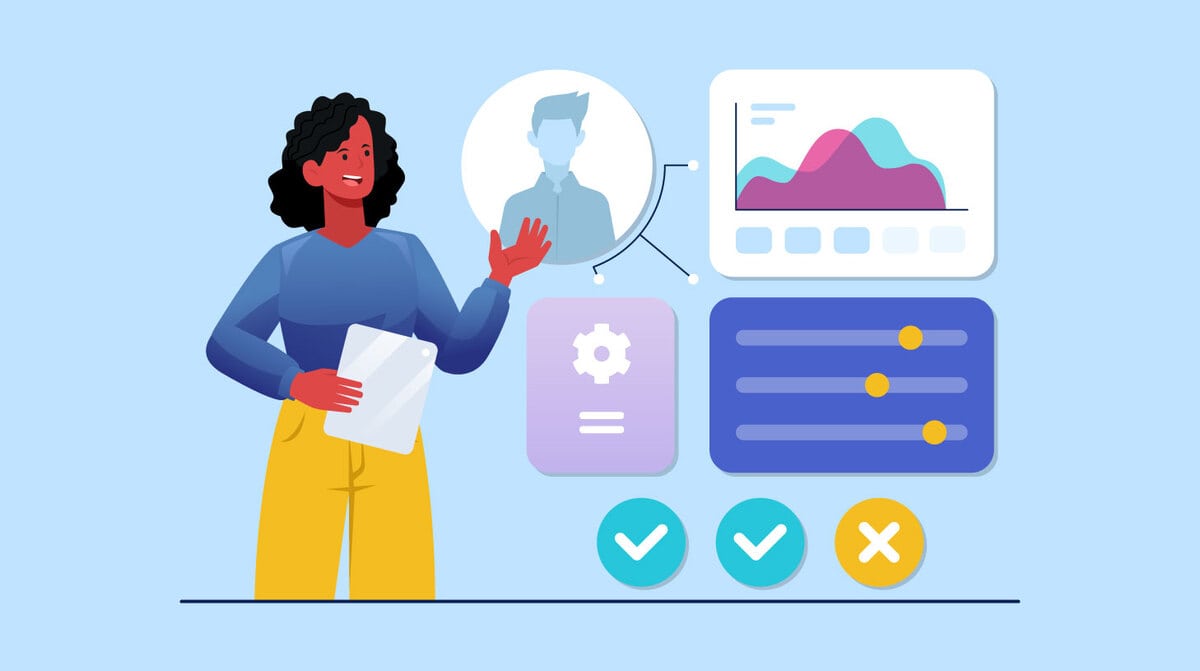Many companies have an established process for what interview format they use at each stage of the interview process.
However, it will serve you well to understand the best practice for each common interview format.
We’re going to break down the most common types of interview formats, the pros and cons of each, and when you might want to use each of them in your hiring process.
Types of Interview Formats
There are several types of interview formats to choose from when structuring your process. In this guide, we will be reviewing the most common, including:
- Phone Interviews
- Video Interviews
- One-on-one Interviews
- Panel Interviews
- Structured Interviews
- Unstructured Interviews
Phone Interview Format
Phone interviews are often used as the first point of contact with candidates who have passed the resume screening test – a sort of interview before the interview.
Conducting a phone Interview can add 6.8 – 8.2 days to the recruitment process.
(Glassdoor)
You may choose to use a phone interview before a face-to-face or video interview to get a feel for the candidate before deciding to move them further into the process.
Some of the PROS to a phone interview include:
- A round of phone interviews can help you narrow down the pool and make the most of your interview time.
- It’s an easy way to validate key requirements and get a better sense of interest.
- After all, your candidate may look great on paper, but you may find during the phone interview that their resume is inflated.
- Or if there’s a red flag related to availability, or interpersonal skills, or general professionalism.
- You can determine if the fit is good enough for you to devote resources to bringing them in for a face-to-face meeting.
- Location is not an issue for either party.
- Phone interviews eliminate travel expenses and save time.
As you can see, that’s quite a list of PROS. A phone interview is a great screening tool and can be helpful for conserving resources, especially if you are a smaller company.
But what are some of the drawbacks to this type of interview format?
Some CONS of the video interview format are:
- Lack of face-to-face interaction. Body language tells a lot about a person, and you won’t be able to see the candidate over the phone.
- You won’t be able to see how they respond under pressure or behave in a professional environment.
- You won’t be able to see the professionalism of their personal appearance and behaviors (hand shake, eye contact, etc.)
All of these CONS are a result of not being able to see the candidate during the interview. A lot of these CONS can be eliminated with a video interview, so that’s what we’ll dig into next.
Skype/Video Interview Formats
Video interviews can be used to screen candidates just like phone interviews, but they have the additional advantage of adding the visual element.
Beyond initial screening, some companies use videos instead of a face-to-face meeting — most often if the position is remote, if the candidate isn’t based locally, or if key interviewers are based in offices in other cities.
On average, video interviews are 6x faster than phone interviews.
Big Cloud
The advantage of a video interview is it gives you some face-to-face time with the candidate without the hassle of arranging an in-person meeting.
Video interviews can help you bypass the need to schedule and conduct dozens of in-person meetings and helps you avoid delays related to scheduling conflicts or travel needs.
As we’ve already mentioned, video interviews can also help you vet candidates more thoroughly than phone interviews because you get a better sense of the candidate through their expressions and body language.
While video interviews are a great option, there can be some CONS to this interview format:
- Technical issues can arise. Especially if the candidate is not used to the software or hardware they are using. Even if they’re a technical pro, internet issues can cause awkwardness and interruptions throughout the interview.
- Camera Discomfort can cause a candidate who is usually relaxed and confident to appear overly stiff and formal while on camera. In other words, you may not get an accurate representation of the candidate’s personality through video.
- Unconscious bias can creep in based on the candidate’s appearance because of bad lighting, poor camera angle, or physical environment. You want to keep your evaluation focused on their ability to do the job, not on how they appear on camera.
One-On-One Vs. Panel Interviews
Once you’re ready to bring in the most promising applicants to meet face-to-face, you can choose to meet them for a one-on-one interview or a panel interview.
Which interview format should you choose?
There are pros and cons to both, so let’s dig a little deeper to help you figure out which will be best for your company.
One-On-One Interview Format
The one-on-one interview format is a bit more intimate, allowing you to make a more personal connection with the candidate and get to know them better.
One-on-one interviews may speed up the hiring process as well since it eliminates the time needed to schedule a panel interview that works with multiple schedules.
Be careful how you structure your interviews however because you can burn through that time savings by bringing the candidate in multiple times for one-on-one interviews.
Remember, the more time it takes to conduct interviews and reach a hiring decision, the higher the possibility the candidate will get scooped up by someone else.
This is why it’s good to design your interview process so you know who needs to be involved in each round.
Then you can schedule more efficiently — for example, covering all three of the round 1 one-on-one interviews on the same day.
However, it may be difficult to schedule efficiently in spite of your best efforts, due to other invested parties being out of the office or unavailable when you need to interview a new candidate.
This can be a CON to the one-on-one approach. You may intend to save time with a one-on-one meeting, but end up having to spend more time bringing the same candidate in again and again. (This is where the panel interview can come in handy, which we will discuss next.)
Another drawback to the one-on-one interview format is that you don’t have the benefit of another set of eyes and a different perspective. You may miss red flags or follow-up questions that a colleague would catch. You may also be more prone to unconscious bias if you are the only evaluator.
Having more than one hiring manager in the interview room can help with all of these CONS, which brings us to…
Panel Interview Format
Panel interviews are typically conducted with 2-5 interviewers from multiple departments that are relevant to the position.
Everyone present plays an important part in the hiring decision, but there is usually one person who is the “leader,” who guides the conversation.
Often that leadership role goes to you, the hiring manager.
The panel interview format gives you the advantage of having all relevant team members present hearing the same things at the same time.
And you can avoid annoying the candidate with repetitive questions and multiple trips into the office.
Most importantly, there can be real benefits from having more than one perspective in the room at the same time.
For example, one of your team members may have an extremely thoughtful follow-up question that didn’t occur to you.
Someone else may notice a red flag that you missed.
It generally makes for a more thorough interview.
Conducting a group panel interview can add 5.6 – 6.8 days to the recruitment process.
(Glassdoor 2015)
In a panel interview you can determine:
- The candidate’s reaction to stress and “rapid-fire” questioning
- How (and if) they interact with all members of the panel
- Flexibility in their communication styles
- Their reactions to different members within the organization.
Panel interviews are commonly used at academic institutions, government-related agencies like the United Nations and its affiliates, and large non-profits.
They are also used in many companies.
One downside of the panel interview is that it requires more planning.
Not just scheduling, but also coordinating with other interviewers to plan who will ask which questions, etc.
And keep in mind that panel interviews can sometimes feel more intimidating for candidates.
Structured Vs. Unstructured Interview Formats
A structured interview is designed around asking a predetermined set of questions to all candidates.
The unstructured interview is more free-flowing and not designed beforehand.
Here at Big Interview, we believe that you’ll make better and more objective hiring decisions by using a structured approach.
All are asked the same questions in the same order and then scored by the same standards.
This levels the playing field by leaving little room for bias.
But some interviewers argue that the unstructured interview format feels more natural.
They don’t like the regimented feeling of a structured interview.
In addition, structured interviews take more planning.
We would argue that this planning time — which is mostly spent getting crystal clear about your priorities for the role — will save you time during evaluation and decision-making.
And it will also help you avoid expensive and time-consuming hiring mistakes.
There are ways to combine the best parts of structured and unstructured interviews.
You can take a structured approach in defining your requirements, selecting consistent questions, and choosing consistent rating criteria.
Then you can build in some unstructured time for follow-up questions and more spontaneous discussion.
Conclusion About Interview Formats
Alright, there you have it, a break-down of the most common interview formats and when you might use them.
Every type of interview format has its pros and cons. Work with your HR department to determine which approach is right for your company based on your resources and hiring strategy.
With a good understanding of interview formats under your belt, you are now in a stronger position to design the perfect interview process to find and retain the best candidates.







